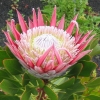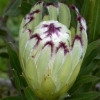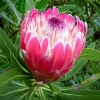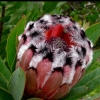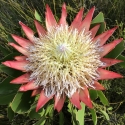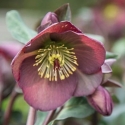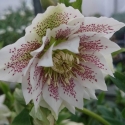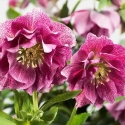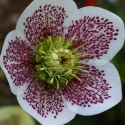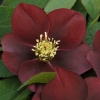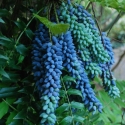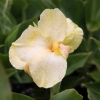Thursday 31st May, 2018
Hi
Stormy weather and no power herald in the arrival of our new season roses
We received a notice in the mail that put me in a bit of a spin.... "there will be a planned power outage from 9.30 am to 3 pm on Wednesday the 23rd of May"... the very same day that we had organised to start potting the newly delivered roses.
My first thoughts are O M G nothing works without power!... what do we do with the admin team for the day, how do we scan the roses into stock, how do we record all the customer sales for the day to keep our inventory accurate let alone irrigate the plants, make hot water for staff breaks, light the offices, flush the toilet and the list goes on...
Our thoughts turned to getting a generator, to run the office at least, and my new learning curve began... There's more to getting a generator than just that it produces electricity and luckily my IT guy was there to lend advice about watts, kilowatts, UPS and inverters.
To cut to the chase we hired (and I was pleasantly surprised at how economic this was) three generators. One was larger producing 5 to 8 KVA and two smaller ones at 2 to 5 KVA. The larger one, with quite a few electric leads, ran the nuts and bolts of the office, although sadly that didn't run to heaters and lights but certainly kept the computers, wifi and network all running smoothly. The smaller ones each kept the computers and wifi operating at the shop and dispatch.
To be honest I was dreading Wed as the day dawned, actually it didn't dawn at all but was wet and bleak with torrential showers as we made our way to Hire pool at 7 am to get these generators. I am certain that the start of the winters hail storms, heavy showers, cool temperatures and typical Waikato bleak weather always begins when we start potting roses.
Forgetting about the weather and getting on with the day, we went about setting up the potting team and introduced all to the labelling, root pruning and the skill of bagging roses into pb8s before the power was switched off. Next on the days agenda was to get the three generators going so that we could continue both in the office and at the potting area scanning in roses.
I have to say that it was a huge success, the generators worked without a hitch, the potting team did a grand job and the roses were scanned in as usual and it was business as usual.
but then along came Fridays power outage..... unplanned LOL
Just as I was adding the finishing touches to last weeks email, there was another one of those horrendous sleet like showers driving almost horizontal in the wind, and according to those in the office a loud bang.... and instantly no power. A little homework and sighting burn marks on the meter box along with the acrid smell of burning wires, we deduced that the meter box was our problem. The line providers disconnected the pole fuse and our amazing electrical firm were out in literally minutes to fix the switch.. Lucky for us the pole fuse man hung around and reconnected the pole fuse... Then we discovered the modem had packed a sad to boot with a new one being required... All in all the fix happened relatively quickly though just wasn't what I would have planned for the day and no generators organised this time!!!!
How would you describe the flowers of Proteas?... Stunning!
The most awesome grade of these plants that I have seen arrived here this week and some with flowers that I just couldn't resist taking some pictures of...and promptly posted to
Instagram and
facebook.
Proteas are native to south Africa, love a hot sunny garden position that has sharp drainage, will tolerate sandy to clay soils but the key to growing these amazing floral flowers is the drainage. The other main fact to growing these is that they like an acid soil with low nutrient value so don't use fertiliser as these contain phosphates and nitrates. On older plants use a low p native fertiliser and/or sheep pellets can be used if a feed is in order.
A windy position or a spot that has good air movement is preferable. Stake a new plant to ensure it doesn't suffer from root rock and can anchor itself properly. Cut back at, or after, flowering removing half to three quarters of the flower stem. I always say cut them back to enjoy the cut flowers inside.
Protea Cynaroides is commonly called the King Protea. Now the flowers are not just large, they are the largest flower of this genus and is quite distinct in its flower form. The main form of cynaroides has stunning large open satin pink flowers and attractive foliage, not like the flowers that we normally see with petals and the like, the flowers of the King Protea are technically called an inflorescence. These are composite flowers with a collection of flowers in the centre and are surrounded by large colourful bracts... These cool flowers are pollinated by birds, bees and insects all in the search of nectar.
Cynaroides has adapted to grow in harsh environments with dry hot summers and wet cold winters... The other interesting factor about most Proteas is that they have adapted to fires which are essential for reproduction and regeneration. Most Protea would fit into the category of reseeders or resprouters once they have been through a fire. Another cynaroides form is one called Tsitsikamma... This form of cynaroides takes it's name from Tsitsikamma the area of South Africa from which it originates.
Some of my favourite Proteas are the nerifolia forms that have the black and fluffy feathery ends that edge the centre of the flower. There are quite few forms of these cool flowers that lend themselves for picking inside... Check out the following
Nerifoilia Alba, Limelight, Pink Ice,
Red Ice..
Then there are the hybrids, check out
Jazz, Rose Mink and
Susara or click on
Proteas and view all the ones that we now have in stock.
Strawberries for Christmas... then plant now..... they wont mind the frost.
There are some plants that you don't think to plant at this time of year and strawberries is one of them. They come in bare root bundles that need to be planted sooner than later. The idea of getting the strawberries in now is that they will get a good root system growing. When spring hits they will be up and producing flowers so that you will have big fat strawberries for Christmas. Its too easy !!
Strawberries are pretty easy to grow and will perform in pots or in the garden. They do like a good rich medium so mix plenty of compost through the soil and form mounded rows. Plant your strawberries at 30 to 40 cm spacing. Take care when planting these bare root perennials as planting too deep will cause them to be unthrifty and possibly even die. If you take a close look at each plant you will see where the roots begin and the stem part starts. Dibble a hole and plant the roots into the soil ensuring that the sheath stem part is out of the soil. many use straw or weed cloth between the rows to prevent weeds and of course keep the hanging fruit clean..
Top dress with fertiliser through the growing season and keep watered should it dry out while the plant is growing.
Be careful with over the plant watering if the plants are carry a bumper crop as the excess moisture could cause the fruit to go off. If growing these in pots then just use a good brand of potting mix and feed with pot formulated fertilisers.
If you are planting strawberries then get your garlic in too... It likes being planted in the cold as well.
Helleborus We have lots of variety in the winter rose range with
Cinderella and Ruby Daydream shining out as the new season winter roses that just came into stock today. Both bring gorgeous colour for the shaded garden but are also excellent as potted colour. The helleborus colour range has some stunning pinks, whites and speckled flowers, check them all out on the website and watch the facebook or instagram pages for our pics.
Cannas... Harry found a selection of Cannas and managed to do a deal. Cannas are great as foliage plants with their gorgeous large leaves. They can give a tropical feel to an area and the added colour of the intricately coloured flowers can only be an added bonus. I hadn't realised that Canna plants have been used in agriculture as a rich source of starch for both people and animals. They were often used in pond openings as a means of filtration.
Mahonia Oiwakensis ....
Mahonias have been around for years but you don't see them available that often.. Stunning spires of yellow flowers are followed by purplish blue flowers. An evergreen shrub with a tall lanky bamboo like habit forming a slim clump and getting to around 3m tall.
Have a great week.
Lloyd, Harry and the Wairere Team
Make it a Wairere weekend where even GNOMES know that gardening's not a drag.
